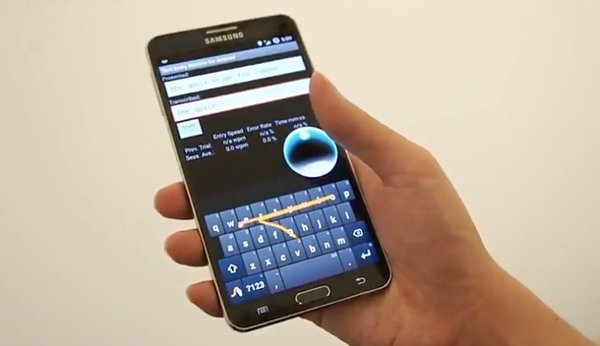If the future of voice control is rapidly coming, nerds like me who use the keyboard will become species that are on the verge of extinction. But in the medium term, our fingertips will still wander on the screen, typing the text is still the core (of course, I did not calculate like to send voice partners).
At the same time, from wearables to VR heads, the number and type of computing devices are more than ever before, so user interface researchers are looking for more reasons to optimize keyboard-based interactions.
INTRODUCTION: A group led by the graduate student Hui-Shyong Yeo of the University of St Andrews presented a tilt-based typing technique. At first glance, this provides an alternative to large smartphone or tablet users: You can type one hand, even if one hand cannot master the entire screen.
Researchers simply referred to this tilt-based typing as SWiM (Shape Writing in Motion). The core text input technology is similar to a gesture-based keyboard, such as Swype, in which the user swipes the letters in alphabetical order of the word to different words, thereby spelling out the words (indeed, they use Swype's interface). But the difference is that SWiM users need to tilt the device through their wrists to create the shadows needed to spell words. So, without a finger drag, just a dexterous wrist.

They wrote in a detailed study of the study: "The dexterous hands usually exhibit finer temporal and spatial resolutions." The researchers also pointed out that their technique relies only on tilting and rolling because "the use of hand yaw The dexterity is very limited."
They added: "Our tilt-based technology allows one-handed input of text, and it is also suitable as a text input method for remote controls, wearables, and virtual reality."
The researchers found that users who used the technology for the first time were able to achieve a rate of 15 words per minute after “a small amount of practice†and a rate of 32 words per minute after approximately 90 minutes of practice.
In order to use the tilt method to start and end text typing (using an accelerometer/gyroscope embedded in a modern smartphone), the researchers came up with an extra button they called "chat head." This is a semi-transparent bubble-like object that locates the user on the screen. In order to use SWiM typing, the user can click on the chat head and start typing the word by tilting the pointer ball over the button, then click on the second chat head to complete the word typing.
The chat head also supports gestures such as sliding left and right for other gesture-based functions. For example, remove the word from the suggestion bar above the keyboard. In addition, the user can also select words from the suggestion bar by tilting the pointer to the suggested word and short pressing the chat head.
In the paper, researchers described SWiM as "more rapid and easier to learn than many existing one-handed text input technologies." In the study, a small number of participants used the technique for transcription and writing tasks (while comparing their input with standard typing and standard body input).
The study also used a vertical pilot to understand specific performance. Participants were required to conduct six separate typing sessions: the first was 15.60 words per minute, the third was 32.18 words per minute, and the improvement rate was 106.3%. At the end of all sessions, this approach has greater gain than normal typing (22.8%) and normal body input (29.5%).
Some people have previously used tilt as an input method for typing text, but this experiment has not yet become any extended commercial promotion. However, as more types of devices appear in the market, including those that use very small screens, or use difficult-to-touch screens, the need for alternative and/or complementary input methods is increasing.
The researchers highlighted the potential of this technology in VR. They wrote: "We believe that our technology is very suitable for typing in virtual reality applications. When you wear VR headsets, users often do not see the keyboard. Therefore, simple controllers that support tilt (such as Google VR controller and Oculus Touch) can use SWiM for text input. Our research shows that this technology has a very high immediate effect and is very fast."
They plan to introduce an installable keyboard version for touch screen device users. They wrote: "In the future, we plan to integrate our technology into the gesture keyboard and publish it as an installable touchscreen keyboard application."
“We will continue to investigate what factors influence the tilt-based physical input and hope to improve SWiM over time. Finally, our goal is to use this technology on other devices, such as smart watches and headsets. The tilt sensor is already built in."
rubber silicone cell phone case,silicone rubber cover phone case,silicone rubber mobile cover,rubber phone case
Dongguan Yingxin Technology Co., Ltd. , https://www.yxsparepart.com